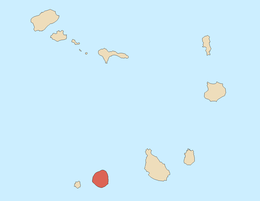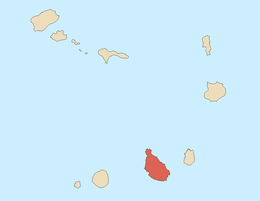Famine in Cape Verde
Part of a series on the |
|---|
| History of Cape Verde |
| Colonial history |
| Independence struggle |
|
|
The archipelago of Cape Verde were struck by a series of famines that began in 1747 and ended in around the 1950s. The famine caused a part of the population to emigrate.
History
The first famine in Cape Verde started in 1747 as deforestation and overgrazing in parts of the islands caused the grounds to become dry with desertification, drought problems occurred. Another famine struck in 1774, in which 20,000 people starved. The hardest hit were the islands of Fogo and Brava. During that time, the population of Fogo dropped from 5,700 to 4,200. Also, all livestock on the island of Fogo disappeared, including cows, sheep, and goats.
In the mid-1820s, Mindelo on the island of São Vicente suffered a drought and famine and lost a part of the population.
Another famine struck from 1831 to 1833 which attempted to move to colonial capital from Praia to Picos. The Portuguese sent almost no relief aid.
One of the later famines of the 1840s depopulated the whole island of Santa Luzia.
Another famine occurred in 1855 and affected Santiago and some other islands, as a result, the governor temporarily moved the residence from Praia (then Porto Praya) to Picos, Praia remained colonial capital[1]
At the end of the 19th century, around 100,000 people starved.
On the island of São Vicente, Mindelo hunger started rising from April 1891. It was rarely hit by the famine until 1900. An increase of food shortage began on the island which later resulted in a strike. The economy of São Vicente and Mindelo was declining as fewer ships stopped at the port and fewer telegraph signals.
As the United States closed immigration in the early 1920s, the famine situation got worse and after the Great Depression struck even in Cape Verde, it affected every island in Cape Verde. First in Mindelo, strikes were organized over food shortages and later rioted on June 7, 1934 after people demanded justice. Later emigration occurred in Mindelo and then in other islands.
One of the last famines occurred, first between 1941 and 1942 and then between 1946 and 1949 and caused a part of the population to move to another colony, São Tomé and Príncipe, one of the hard hit was the island of São Nicolau, Boa Vista, Maio, Santiago including Ribeira da Barca, Mindelo on São Vicente, Santo Antão, Fogo and Brava, the least affected was Sal, it had a small population in the 1940s, as the airport opened, a part of the population moved there and had water and food supplies. This was one of the factors of the rise of support for Cape Verdean independence. Later hungers were minimal in later years and caused the population to immigrate to Senegal and western Europe including France. Hunger problems ended in 1968 as some food aid by families abroad were brought to Cape Verde. The remains of hunger had disappeared entirely after Cape Verde became independent in 1975. Though emigration continued in smaller numbers after independence for some years, not related to famine. Also its farming capability has never been high as only 11% of the land were arable in 2005 (now it is around 15%), the country produced between 15-20% of its own foodstuffs in the 1990s, but a lot of foodstuffs were imported into Cape Verde from other countries including Portugal and the United States especially food aid which continues into the present day.
During the famine, other villages in south and other parts of Boa Vista became abandoned including Curral Velho, Prazeres and Espinguera, some other islands were included including Castilhano on São Nicolau.
In popular culture
Several singers had made songs about the recent famines of Cape Verde especially the one in 1947, some of them were made by artists that lived during the famines. One of the songs was "Fomi 47" ("Fome de 47") by Codé di Dona. That song would be sung by others including the Finaçon.[2]
Morna songs were heard during the times of the famine and related to the problems it had.
In literature, Baltasar Lopes da Silva published his Chiquinho, the third part titled "The Waters" (As Águas), the third and final part of the novel, This part is focused on the calamity of drought, a major problem in Cape Verde, which results in famine and many deaths. At the end of the novel, Chiquinho emigrates to the United States with the hope of a better life.[3] Manuel Lopes with Galo Cantou na Baía which was about hunger that struck at the time, Luís Romano de Madeira Melo also published his first novel Famintos (Famine, Hunger), about the deaths of several Cape Verdeans during the drought of the 1940s, it was written in 1940, as it was censored at the time, it was published in Brazil in 1962.[4][5]
See also
References
- ↑ Michel Cahen (dir.), "Vilas" et "cidades" : bourgs et villes en Afrique lusophone (preface by Catherine Coquery-Vidrovitch), L'Harmattan, Paris, 1989, p. 30 ISBN 2-7384-0431-6
- ↑ "Finacon". allmusic.com. Retrieved 2016-11-17.
- ↑ "Chiquinho and Baltasar: Mark of Cape Verde's literature". Retrieved November 8, 2016.
- ↑ Chalendar, Pierrete and Gérard, no. 27
- ↑ SATO, Maria Helena e Romano Luís. O Poeta Além-Vale António Januário Leite. Campinas: Editora Komedi, 2005. p. 208
Further reading
- Luís de Albuquerque, Maria Emília Madeira Santos, História geral de Cabo Verde (General History of Cape Verde), Centro de Estudos de História e Cartografia Antiga ; Instituto de Investigação cientifica tropical, Lisbon ; Instituto Nacional de Investigação Cultural de Cabo Verde, Praia, 2001, 2 vol. : vol. I, ISBN 972-672-894-0 ; vol. II ISBN 972-672-895-9
- Germano Almeida, Cabo Verde: Viagem pela história das ilhas, Caminho, Lisbon, 2003, ISBN 972-21-1544-8
- André Barbe, Les îles du Cap-Vert, de la découverte à nos jours, une introduction : de l'entrepôt des esclaves à la nation créole (préf. de Cesária Évora), L'Harmattan, 2003 ISBN 2-7475-3730-7
- Barcelos, Christiano José de Senna. Subsídios para a História de Cabo Verde. Cidade da Praia: Instituto da Biblioteca Nacional e do Livro, 2003.
- George E. Brooks: Cabo Verde: Gulag of the South Atlantic: Racism, Fishing Prohibitions, and Famines. History in Africa, 33, African Studies Association 2006, S. 101–135
- Voix des îles du Cap-Vert de Luis Romano (Voices of the Cape Verde Islands by Luís Romano) , article by Pierrette et Gérard Chalendar in Éthiopiques, no 27, July 1981 (in French)
- Richard A. Lobban Jr and Paul Khalil Saucier, Historical dictionary of the Republic of Cape Verde, Scarecrow Press, Lanham, Maryland ; Toronto ; Plymouth, UK, 2007, LII ISBN 978-0-8108-4906-8
- Maria Emília Madeira Santos, Maria Manuel Ferraz Torrão, Maria João Soares, História concisa de Cabo Verde : resumo da História geral de Cabo Verde (Concise History of Cape Verde), Instituto de Investigação Científica Tropical, Lisbonne ; Instituto da Investigação e do Património Culturais, Praia, 2007 ISBN 978-972-672-973-0
- Idelette Muzart-Fonseca dos Santos, José Manuel Da Costa Esteves and Denis Rolland, Les îles du Cap-Vert : langues, mémoires, histoire, L'Harmattan, 2007 ISBN 978-2-296-04633-7
- Daniel A. Pereira, Estudos da história de Cabo Verde (Studies on History of Cape Verde), Alfa-Comunicações, Praia, 2005, 2nd ed.

